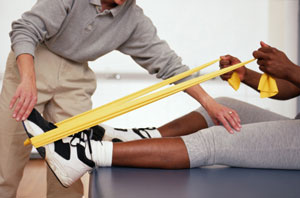Much is written and talked about “sitting disease”
It’s not good for your back, neck, hips, not to mention your heart and other vital organs. But, it is not just “sitting”. Today’s blog takes a different perspective on “sitting disease”. You may be privy to this perspective simply by visiting my office, but this is the first time I’m putting pen to paper fingertip to keyboard.
Sitting, alone, is not the problem.
 The overall sedentary lives we’re leading is the problem. If you take a step back and look at humanity as a whole you begin to realize that we are the first humans to not move very much. For thousands of years (or millions, I don’t know – too big a discussion for this blog), humans moved all day, only stopping to rest at night. Manual labour, working the fields, walking from streams to wells, etc. was the norm. Only in our recent generation of humanity – say 100 – 200 years – have we stopped moving throughout our days. Planes, trains, and automobiles; Desks and computers; Television and movie theatres. When you add up the hours spent sitting (I’m doing it right now, as I type), the number is horrifically high. Too high. Our bodies are ‘learning’ to not move.
The overall sedentary lives we’re leading is the problem. If you take a step back and look at humanity as a whole you begin to realize that we are the first humans to not move very much. For thousands of years (or millions, I don’t know – too big a discussion for this blog), humans moved all day, only stopping to rest at night. Manual labour, working the fields, walking from streams to wells, etc. was the norm. Only in our recent generation of humanity – say 100 – 200 years – have we stopped moving throughout our days. Planes, trains, and automobiles; Desks and computers; Television and movie theatres. When you add up the hours spent sitting (I’m doing it right now, as I type), the number is horrifically high. Too high. Our bodies are ‘learning’ to not move.
Arthritis is Not Normal
Perhaps you’re a patient of mine who has heard me say, “Arthritis is not normal. It is common. So common that we’ve evolved to call it ‘normal’. But it’s not normal. Common and normal are very different”. Arthritis is the body shutting down a joint. When we cease to use a joint, the nervous system shuts it down. Just like a corporation that shuts down an unprofitable sector, our brain decides that if we’re not going to use the joint, we might as well shut it down. Of course, we can adapt to not having all of our joints playing nicely together because if we don’t use one joint, then it’s neighbour will do the job. Unfortunately, this is not fair to the neighbour and it will wear itself out and be shut down early too. There is no escaping arthritis, other than using our bodies the way they’re intended to be used.
I have the privilege of helping my patients rid themselves of pain, to move better, and live healthier, happier lives. Having this discussion about our lack of movement is central to the way I help. Typically, a patient will visit my office for the first time with either a new ache/pain or an old one that has persisted too long. During my examination, I will usually find areas of the body that are shutting down the use of the joints (or already have). Sometimes this is the site of the pain, but sometimes it is not. For example: Patient X has neck pain, but upon examination the neck joints actually move fairly well. When I look a little further, the upper back proves to be rock solid! This is why the neck hurts! It’s doing way more work than it is supposed to. Eventually, the upper back will start hurting too.
Chunking and Functional Range Conditioning
 My former classmate and creator of Functional Range Conditioning, Functional Release, and the coming soon KinStretch class, Dr. Andreo Spina, calls this “chunking”. Chunking refers to when sections of the spine pick up the slack for neighbouring sections of the spine. Just like if one joint is stuck, its neighbour will move more, the spine learns to chunk by having whole sections move excessively to pick up the slack for the ‘chunks’ not moving at all. You don’t want this. This is why I help you identify which joints are moving, which ones aren’t, whether you have ‘chunks’, and then prescribe you methods to actively move those joints to restore healthy motion. Segmental Cat/Camels, FRC joint mobility exercises, Controlled Articular Rotations (CARs) are becoming the gold standard for joint mechanic rehabilitation. Teaching FRC principles to my patients has become the most important tool in my toolbox. Spinal manipulation, Laser, Graston, soft tissue therapy are all really important passive treatments to help patients recover, but the active (read: you do it yourself at home/gym) component is essential.
My former classmate and creator of Functional Range Conditioning, Functional Release, and the coming soon KinStretch class, Dr. Andreo Spina, calls this “chunking”. Chunking refers to when sections of the spine pick up the slack for neighbouring sections of the spine. Just like if one joint is stuck, its neighbour will move more, the spine learns to chunk by having whole sections move excessively to pick up the slack for the ‘chunks’ not moving at all. You don’t want this. This is why I help you identify which joints are moving, which ones aren’t, whether you have ‘chunks’, and then prescribe you methods to actively move those joints to restore healthy motion. Segmental Cat/Camels, FRC joint mobility exercises, Controlled Articular Rotations (CARs) are becoming the gold standard for joint mechanic rehabilitation. Teaching FRC principles to my patients has become the most important tool in my toolbox. Spinal manipulation, Laser, Graston, soft tissue therapy are all really important passive treatments to help patients recover, but the active (read: you do it yourself at home/gym) component is essential.
We don’t need to just “exercise” more either.
“Exercise” as we typically know it is not really the answer either. Don’t get me wrong – it’s not bad. It’s amazing. Running, cycling, swimming, weights, sports, etc. are challenging, fun, social, and good for you. But, just as some of those are good for your heart, or your muscle strength, we need to emphasize how to take care of our joints. Otherwise, arthritis will still be common or “normal”. We need to incorporate the principles of Functional Range Conditioning (FRC) into our daily lives to make sure our lumbar spinal joints articulate as they’re intended. Our neck needs to stop compensating for our upper backs. We need to make sure we can control our shoulder blade motion (a huge percentage of us cannot – which triggers upper back and neck complaints). And hips – we need to move our hips in ways other than “walking”.
If you’re reading this blog to this point but have not been in to see me to learn about this first hand, please do. It’s not complicated, yet critical to your body’s health. If you have heard me ramble on about this, thanks for indulging me. Now, indulge yourself by doing these exercises and continuing the pursuit to move the way your human frame was intended. Your lifelong functionality depends on it.
I’m not a Star Trek fan (“trekkie”, is it?), but in the words of Spock: “Live long and prosper”!
Dr. Michael Berenstein
